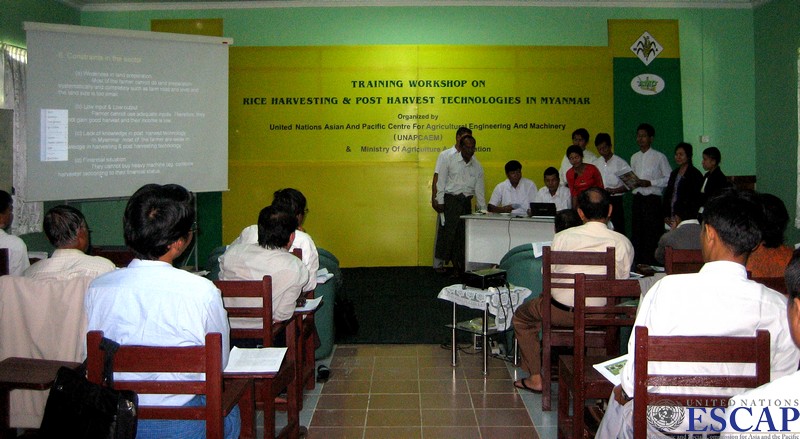UNAPCAEM Launched a Pilot Project to Reduce Post-Harvest Losses in Rice Production in Myanmar

Rice is the major crop for millions living in Asia and the Pacific, and 90 percent of the world's output of rice is produced and consumed within Asia. Although most Asian rice farms are small holders, they employ intensive labor practices in place of mechanization. With limited land, huge population and lingering food insecurity exacerbated by the lingering effects of the global financial crisis and climate change, a viable option is to create food surpluses by increasing land productivity through the introduction of efficient and adaptable small-scale machinery into rice production farming systems in the region.
Myanmar is a rice growing country with a relatively small population and abundant land and water resources. Therefore, Myanmar faces the acute challenge of mechanizing its agricultural sector to increase productivity and reduce post-harvest losses. Currently, the post harvest losses in rice production in Mynamar stand at 10-20%. The government of Myanmar has made development of agriculture through mechanization and application of modern agro-technologies a priority in the overall national economic development. However, the present capacity of the Government's Agricultural Mechanization Department (AMD) is limited; at the same time the role of Myanmar's burgeoning private sector that produces agricultural machinery needs exposure to the latest technological developments. Enhancing the capacity of both will assist Myanmar in achieving its targets to mechanize the agricultural sector.
In response, UNAPCAEM designed a project to build the capacity of agricultural technicians, extension workers, government officials and the private sector of Myanmar in addressing post-harvest losses in rice production through introduction of practical on-farm post harvest technologies, suitable and locally adaptable machineries and good agricultural practices.
As a first step, a fact-finding mission was conducted by UNAPCAEM on 11-13 October 2010 to collect the most up-to-date information on constraints and challenges with post-harvest technologies in Myanmar through visits to research institutes, extension services and talks with government officials and private sector representatives.
Then, in collaboration with the Ministry of Agriculture and Irrigation of Myanmar, UNAPCAEM organized a training on post-harvest technology for rice production in Myanmar from 16-20 December 2010. Fifty technicians, engineers, extension workers, as well as representatives from the research institutes, the private sector and rice miller associations from across the country joined the week-long training. The training covered drying, storage, processing as well as harvesting technologies in rice production. The project enjoyed technical support from the Asian Institute of Technology of Thailand and Jiangsu University of China.
As a supplement to the training, a policy workshop was held on 21 December with participation of over 30 policy makers from various departments of the government. At the workshop, UNAPCAEM made a presentation to share the key findings and provided policy recommendations on how to mechanize the country’s agricultural sector. Experts of UNAPCAEM also shared best practices and useful experiences in mechanization of rice production from neighboring countries.
Successful implementation of this project is expected to result in a package of suitable post-harvest technologies, including utilization of energy-efficient machineries adaptable to local conditions, which Myanmar could adopt to reduce post-harvest losses.
In addition, a training manual on post-harvest technologies in rice production farming systems will be prepared and uploaded on UNAPCAEM website.
